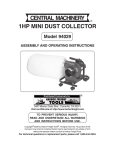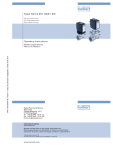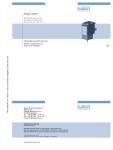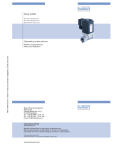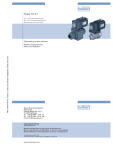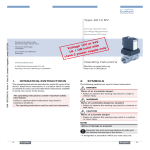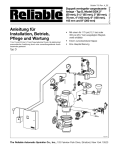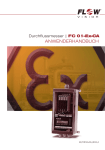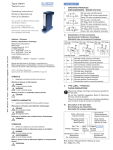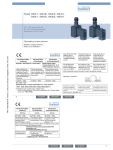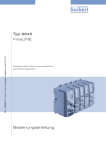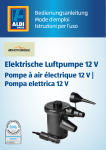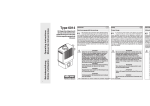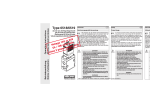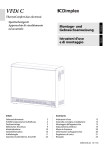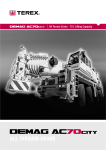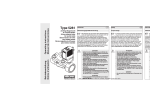Download Type 0470, 5470
Transcript
Type 0470, 5470 3/2 or 4/2 way solenoid valve 3/2- bzw. 4/2-Wege-Magnetventil Électrovanne 3/2 ou 4/2 voies Operating Instructions Bedienungsanleitung Manuel d‘utilisation Bürkert Fluid Control Systems Sales Center Christian-Bürkert-Str. 13-17 D-74653 Ingelfingen Tel. + 49 (0) 7940 - 10 91 111 Fax + 49 (0) 7940 - 10 91 448 E-mail: [email protected] International address www.burkert.com Manuals and data sheets on the Internet: www.burkert.com Bedienungsanleitungen und Datenblätter im Internet: www.buerkert.de Manuels et fiches techniques sur Internet : www.buerkert.fr © Bürkert Werke GmbH, 2015 Operating Instructions 1502/14_EU-ML_00803445 / Original DE www.burkert.com EN Type 0470, 5470 1 THE OPERATING INSTRUCTIONS The operating instructions contain important information. ▶▶ Read the operating instructions carefully and follow the safety instructions in particular. ▶▶ The operating instructions must be available to every user. ▶▶ The liability and warranty for Type 0470, 5470 are not applicable if the operating instructions are not followed. 1.1 Symbols ▶▶ Designates instructions for risk prevention. →→Designates a procedure which you must carry out. Warning of serious or fatal injuries: DANGER! In case of imminent danger. Warning of minor or moderately severe injuries: CAUTION! WARNING! In case of potential danger. Warning of damage: NOTE! 1.2 Definition of the term “device” The term “device” used in the instructions always refers to the Type 0470, 5470. INTENDED USE Incorrect use of the solenoid valve Type 0470, 5470 may be a hazard to people, nearby equipment and the surrounding area. ▶▶ The device is used exclusively as 3/2 or 4/2-way solenoid valve for the media permitted according to the data sheet of the corresponding type. ▶▶ Provided the cable plug is connected and installed correctly, e.g. Bürkert Type 2506 (for Type 5470) or Type 1054 (for Type 0470), the device satisfies degree of protection IP65 in accordance with DIN EN 60529 / IEC 60529. ▶▶ In a hazardous area, the device may be used only in accordance with the specification on the separate Ex type label. For the use, observe the additional information enclosed with the device with safety instructions for the EX area. ▶▶ Devices without a separate Ex type label may not be used in a potentially explosive area. ▶▶ Use according to the authorized data, operating conditions and conditions of use specified in the contract documents, the data sheet and the operating instructions. ▶▶ Correct transport, correct storage and installation as well as careful use and maintenance are essential for reliable and problem-free operation. ▶▶ Use the device only for its intended purpose. english 2 3 2 BASIC SAFETY INSTRUCTIONS These safety instructions do not make allowance for any contingencies and events which may arise during assembly, operation and maintenance. Danger – high pressure! ▶▶ Turn off the pressure and vent the lines before loosening lines or valves. Risk of electric shock! ▶▶ Before reaching into the device or the equipment, switch off the power supply and secure to prevent reactivation! ▶▶ Observe applicable accident prevention and safety regulations for electrical equipment! Risk of injury from greatly accelerated device parts! ▶▶ Before pressurizing the valve, check that all screw connections and screw joints are tight and secure. Risk of burns/danger of fire during long-term operation due to hot device surface! ▶▶ Keep the device away from highly flammable substances and media and do not touch with bare hands. To prevent injuries/damage: ▶▶ Do not make any internal or external changes to the device and safeguard against unintentional actuation. ▶▶ Installation and maintenance work may be carried out only by authorized technicians with the appropriate tools. ▶▶ After an interruption in the electrical or pneumatic supply, ensure that the process is restarted in a defined or controlled manner. ▶▶ Do not subject the housing to mechanical loads. ▶▶ Observe the general accepted technical rules. 3.1 Restrictions If exporting the device, observe any existing restrictions. english 4 5 APPROVALS 3 STRUCTURE AND FUNCTION The approval mark indicated on the Bürkert labels refers to the Bürkert products. The valves can be mounted in blocks on the modular pneumatic base rail Type MP05. Devices which must bear the type approval mark were approved at the Kraftfahrtbundesamt under the type approval number 5.1 Structure of the standard designs e1*72/245*2006/96*5791*00 5.1.1Connections and are put into circulation with the indicated type approval mark. All connections are identified by numbers on the valve surface. These refer to the following functions: e1 035791 You can obtain an extract of the type approval from the address below. Bürkert Werke GmbH CQ-Approval Management Christian-Bürkert-Str.13-17 D-74653 Ingelfingen 4 english Number 1 2 und 4 3 Function Pressure inlet port Working port Exhaust port Type 0470, 5470 5.2 Circuit functions 5.1.2Valve structure Type 5470 Cable plug Type 2506 Pilot valve Type 6106 C 3/2-way valve Normally inlet port 1 closed, working port 2 connected with exhaust port 3. D 3/2-way valve Normally inlet port 1 connected with working port 2, exhaust port 3 closed. Manual control Exhaust port 3 Pressure inlet port 1 G Working port 4 B Working port 2 P R 5.1.3Valve structure Type 0470 4/2-way valve Normally inlet port 1 connected with working port 2, working port 4 connected with exhaust port 3. Cable plug Type 1054 Solenoid coil Type AC27 Exhaust port 3 Pressure inlet port 1 Working port 4 Working port 2 english 6 TECHNICAL DATA 6.4 Operating conditions Please observe the specifications on the data sheet and on the type label. 6.1 Conformity The solenoid valve Type 0470, 5470 is compliant with EC directives as stated in the EC Declaration of Conformity. 6.2 Standards The applied standards which are used to demonstrate compliance with the EC Directives are listed in the EC Prototype Examination Certificate and/or the EC Declaration of Conformity. 6.3 Type label Circuit function Example: Made in Germany Type Order number Fig. 1: 5470 G1/8 24V G 4,0 PN2–10bar DC 2W 00203236W1YMG 5 Orifice Connection type, permitted pressure range Voltage (± 10 %), frequency, output Manufacturer code Example of type label on the pilot-controlled solenoid valve Type 5470 Ambient temperature Permitted medium temp. Compr. air quality Permitted media Permitted pressure range Degree of protection Operating duration –10 °C ... +55 °C (please observe temperature restrictions on account of approvals) –10 °C ... +50 °C ISO 8573-1:2010, Class 7.4.41) Filtered compressed air oiled and unoiled, neutral gases Observe specifications on type label Pressure difference at least 2 bar between ports 1 and 3 IP65 as per DIN EN 60529 / IEC 60529 with correctly connected and fitted cable plug, e.g. Bürkert Type 2506 Unless otherwise indicated on the type label, the solenoid system is suitable for continuous operation To prevent the expanded compressed air from freezing, its pressure dew point must be at least 10 K lower than the medium temperature. 1) english 6 Important information for functional reliability during continuous operation! If the equipment is switched off for a long period, it is recommended to activate the valves at least 1-2 per day. Service life: High switching frequency and high pressures reduce the service life. The valves operate maintenance-free. 6.5 Materials Housing material: PA Seal material: NBR 7 ASSEMBLY 7.1 Safety instructions DANGER! Risk of injury from high pressure in the system! ▶▶ Turn off the pressure and vent the lines before loosening lines or valves. Risk of injury due to electrical shock! ▶▶ Before reaching into the device or the equipment, switch off the power supply and secure to prevent reactivation! ▶▶ Observe applicable accident prevention and safety regulations for electrical equipment! WARNING! Risk of injury from greatly accelerated device parts and unconnected whiplashing compressed air hoses! ▶▶ Before pressurizing the valve, check that all screw connections and screw joints are tight and secure. Risk of injury from improper assembly! ▶▶ Assembly may only be carried out by authorized technicians and with the appropriate tools! english 7 Type 0470, 5470 Risk of injury from unintentional activation of the system and uncontrolled restart! ▶▶ Secure system against unintentional activation. ▶▶ Following assembly, ensure a controlled restart. Tightening torque 1st Level 0.1 Nm (± 0.05 Nm), 2nd Level 0.2 Nm (± 0.05 Nm). 7.2 Type 5470, turning the solenoid coil The valves are supplied fully assembled. If the solenoid coil in the pilot valve is in an unfavorable position for installation, the coil can be turned 180°. 180° WARNING! Risk of electrical shock if the coil is incorrectly fitted! ▶▶ During installation, make sure that the coil is firmly seated on the valve body so that the protective conductor connection of the coil is in contact with the valve housing. ▶▶ Check the function of the protective conductor (for test values, see “Tab. 1”, page 11). Fig. 2: Typ 5470: The solenoid coil in the pilot valve can be turned by 180° →→Loosen M2 screws and pull coil away from the valve body. →→Turn coil, attach to valve body, and screw on with M2 screws, tightening alternately step by step. While doing so, observe the tightening torque: english 8 7.3 Conversion from a 4/2 to a 3/2 way valve To convert the 4/2-way valve into a 3/2-way valve, you must seal connection 2 or connection 4 with a plug depending on the required operating principle. Connection 2 Connection 4 Circuit function sealed open C open sealed D 7.4 Pneumatic connection WARNING! Risk of injury from greatly accelerated device parts and unconnected whiplashing compressed air hoses! ▶▶ Before pressurizing the valve, check that all screw connections and screw joints are tight and secure. Installation position: any, preferably with solenoid system face up. Before connecting: →→Check whether hose lines are dirty and clean. →→If required, install a dirt filter upstream of the valve inlet (≤ 5 µm). Pneumatic connection: NOTE! Risk of breakage! ▶▶ Do not use coil as a lever arm. ▶▶ Do not use a cylinder wrench to tighten screws. →→Hold the device by hand on the housing and connect to the hose line. Do not exceed the standard screw-in depth. →→Seal with PTFE tape or elastomer seal. english →→Observe allocation of the connections (see Chapter “5.1.1 Connections”, page 4). →→Align hose lines. 9 7.5.1Connection of cable plug to the power supply Example Type 5470 7.5 Electrical connection Seal Approved cable plug (e.g. Type 2506 or other in accordance with DIN ISO 175301-803 shape C) WARNING Risk of injury due to electrical shock! ▶▶ Before reaching into the system, switch off the electrical power supply and secure to prevent reactivation! ▶▶ Observe applicable accident prevention and safety regulations for electrical equipment! ▶▶ When screwing the coil onto the device socket, make sure the seal is correctly seated. If the protective conductor contact between the coil and housing is missing, there is a danger of electric shock! ▶▶ Always connect protective conductor. ▶▶ Check electrical continuity between coil and housing. Observe max. tightening torque! Fig. 3: Connection of cable plug to the power supply, Example type 5470 →→Tighten cable plug (for authorized types see data sheet), observing maximum torque (0.3 Nm). →→Check that seal is fitted correctly. →→Connect protective conductor and check electrical continuity between coil and housing (s. “Tab. 1”). 10 english Type 0470, 5470 7.6 Actuating the pulse version NOTE! If the cable plug is designed in such a way that the screw is pointing upwards, insert a seal made of a material compatible with your process under the screw head. The correct polarity is a prerequisite for the device to function: Observe the markings on the coil surface. Pulse duration at least 50 ms. pin 1 pin 2 pin 1 pin 2 Note the voltage and current type as specified on the type label. Pesistor Test voltage Test current max. 0.1 Ω 12 V 1A Tab. 1: Test values protective conductor function Plug configuration Effect (+) on pin 2 (–) on pin 1 Pilot valve opened (+) on pin 1 (–) on pin 2 Pilot valve closed 1–3 2–3 1–4 1–2 4–3 4–3 CFG CFC CFG CFC english 8 MANUAL CONTROL 11 10 MAINTENANCE, TROUBLESHOOTING If the valve is used according to these operating instructions, the valve will operate maintenance-free. 10.1Safety instructions WARNING! 0 = rest position 1 = switching position Fig. 4: 9 Manual control based on the example of Type 5470 DISASSEMBLY Disassembly is in reverse sequence to assembly. 12 Risk of injury from improper maintenance! ▶▶ Maintenance may only be carried out by authorized technicians and with the appropriate tools! Risk of injury due to electrical shock! ▶▶ Before reaching into the device or the equipment, switch off the power supply and secure to prevent reactivation! Danger – high pressure! ▶▶ Turn off the pressure and vent the lines before loosening lines or valves. Risk of injury from unintentional activation of the system and uncontrolled restart! ▶▶ Secure system against unintentional activation. ▶▶ Following maintenance, ensure a controlled restart. english 10.2Malfunctions If malfunctions occur, check whether: •the device has been installed according to the instructions, •the electrical and pneumatic connections are correct, •the device is not damaged, •all screws have been tightened, •the voltage and pressure have been switched on, •the pipelines are clean, •the manual control is in the normal position. Valve does not switch Possible causes: •short circuit or coil interrupted, •core or core area dirty, •medium pressure outside the permitted pressure range. Valve does not close Possible causes: •inner compartment of the valve is dirty. 11 TRANSPORTATION, STORAGE, DISPOSAL NOTE! Transport damage! Inadequately protected devices may be damaged during transportation. ▶▶ Protect the device against moisture and dirt in shock-resistant packaging during transportation. ▶▶ Prevent the temperature from exceeding or dropping below the permitted storage temperature. ▶▶ Protect the electrical interfaces of the coil and the pneumatic connections from damage by placing protective caps on them. Incorrect storage may damage the device. ▶▶ Store the device in a dry and dust-free location! ▶▶ Storage temperature –40 °C ... +80 °C. Damage to the environment caused by device components contaminated with media. ▶▶ Dispose of the device and packaging in an environmentally friendly manner! ▶▶ Observe applicable disposal and environmental regulations. english 13 Type 0470, 5470 3/2 or 4/2 way solenoid valve 3/2- bzw. 4/2-Wege-Magnetventil Électrovanne 3/2 ou 4/2 voies Operating Instructions Bedienungsanleitung Manuel d‘utilisation Bürkert Fluid Control Systems Sales Center Christian-Bürkert-Str. 13-17 D-74653 Ingelfingen Tel. + 49 (0) 7940 - 10 91 111 Fax + 49 (0) 7940 - 10 91 448 E-mail: [email protected] International address www.burkert.com Manuals and data sheets on the Internet: www.burkert.com Bedienungsanleitungen und Datenblätter im Internet: www.buerkert.de Manuels et fiches techniques sur Internet : www.buerkert.fr © Bürkert Werke GmbH, 2015 Operating Instructions 1502/14_EU-ML_00803445 / Original DE www.burkert.com DE Typ 0470, 5470 1 DIE BEDIENUNGSANLEITUNG Die Bedienungsanleitung enthält wichtige Informationen. ▶▶ Die Bedienungsanleitung sorgfältig lesen und die Hinweise zur Sicherheit beachten. ▶▶ Die Bedienungsanleitung muss jedem Benutzer zur Verfügung stehen. ▶▶ Die Haftung und Gewährleistung für Typ 0470, 5470 entfällt, wenn die Anweisungen der Bedienungsanleitung nicht beachtet werden. 1.1 Darstellungsmittel ▶▶ markiert eine Anweisung zur Gefahrenvermeidung. →→markiert einen Arbeitsschritt, den Sie ausführen müssen. Warnung vor schweren oder tödlichen Verletzungen: GEFAHR! WARNUNG! Bei unmittelbarer Gefahr. Warnung vor leichten oder mittelschweren Verletzungen: VORSICHT! Bei möglicher Gefahr. Warnung vor Sachschäden: HINWEIS! 1.2 Begriffsdefinition „Gerät“ Der in der Anleitung verwendete Begriff „Gerät“ bezeichnet immer den Typ 0470, 5470. BESTIMMUNGSGEMÄSSER GEBRAUCH Bei nicht bestimmungsgemäßem Einsatz des Magnetventils Typ 0470, 5470 können Gefahren für Personen, Anlagen in der Umgebung und die Umwelt entstehen. ▶▶ Das Gerät dient ausschließlich als 3/2- bzw. 4/2-Wege-Magnetventil für die laut Datenblatt des entsprechenden Typs zulässigen Medien. ▶▶ Mit einer sachgemäß angeschlossenen und montierten Gerätesteckdose, z. B. Bürkert Typ 2506 (bei Magnetventil Typ 5470) oder Typ 1054 (bei Magnetventil Typ 0470) erfüllt das Gerät die Schutzart IP65 nach DIN EN 60529 / IEC 60529. ▶▶ Im explosionsgefährdeten Bereich darf das Gerät nur entsprechend der Spezifikation auf dem separaten Ex-Typschild eingesetzt werden. Für den Einsatz muss die dem Gerät beiliegende Zusatzinformation mit Sicherheitshinweisen für den Ex-Bereich beachtet werden. ▶▶ Geräte ohne separates Ex-Typschild dürfen nicht im explosionsgefährdeten Bereich eingesetzt werden. ▶▶ Für den Einsatz die in den Vertragsdokumenten, dem Datenblatt und der Bedienungsanleitung spezifizierten zulässigen Daten, Betriebs- und Einsatzbedingungen beachten. ▶▶ Voraussetzungen für den sicheren und einwandfreien Betrieb sind sachgemäßer Transport, sachgemäße Lagerung und Installation sowie sorgfältige Bedienung und Instandhaltung. ▶▶ Das Gerät nur bestimmungsgemäß einsetzen. deutsch 14 3 2 GRUNDLEGENDE SICHERHEITSHINWEISE Diese Sicherheitshinweise berücksichtigen keine Zufälligkeiten und Ereignisse, die bei Montage, Betrieb und Wartung auftreten können. Verletzungsgefahr durch hohen Druck! ▶▶ Vor dem Lösen von Leitungen oder Ventilen den Druck abschalten und Leitungen entlasten. Verletzungsgefahr durch elektrische Spannung! ▶▶ Vor Eingriffen in das Gerät oder die Anlage Spannung abschalten und vor Wiedereinschalten sichern! ▶▶ Die geltenden Unfallverhütungs- und Sicherheitsbestimmungen für elektrische Geräte beachten! Verletzungsgefahr durch stark beschleunigte Geräteteile! ▶▶ Vor Beaufschlagen des Ventils mit Druck alle Schlauchverbindungen und Verschraubungen auf festen, sicheren Sitz überprüfen. Verbrennungsgefahr/Brandgefahr bei Dauerbetrieb durch heiße Geräteoberfläche! ▶▶ Das Gerät von leicht brennbaren Stoffen und Medien fernhalten und nicht mit bloßen Händen berühren. Zum Schutz vor Verletzungen/Sachschäden beachten: ▶▶ Am Gerät keine inneren oder äußeren Veränderungen vornehmen und vor unbeabsichtigter Betätigung sichern. ▶▶ Installations- und Instandhaltungsarbeiten dürfen nur von autorisiertem Fachpersonal mit geeignetem Werkzeug ausgeführt werden. ▶▶ Nach einer Unterbrechung der elektrischen oder pneumatischen Versorgung ist ein definierter oder kontrollierter Wiederanlauf des Prozesses zu gewährleisten. ▶▶ Gehäuse nicht mechanisch belasten. ▶▶ Die allgemeinen Regeln der Technik einhalten. 3.1 Beschränkungen Beachten Sie bei der Ausfuhr des Geräts gegebenenfalls bestehende Beschränkungen. deutsch 4 5 ZULASSUNGEN 15 AUFBAU UND FUNKTION Die auf den Bürkert Typschildern aufgebrachte Zulassungskennzeichnung bezieht sich auf die Bürkert Produkte. Die Ventile können auf der modularen pneumatischen Grundschiene Typ MP05 zu Ventilblöcken montiert werden. Geräte, die das Typgenehmigungszeichen tragen müssen, wurden beim Kraftfahrtbundesamt unter der Typgenehmigungsnummer 5.1 Aufbau der Standard-Ausführungen e1*72/245*2006/96*5791*00 genehmigt und werden mit dem gezeigten Typgenehmigungzeichen in den Verkehr gebracht. e1 035791 Einen Auszug der Typgenehmigung erhalten Sie unter folgender Adresse: Bürkert Werke GmbH CQ-Approval Management Christian-Bürkert-Str.13-17 D-74653 Ingelfingen 16 deutsch 5.1.1Anschlüsse Alle Anschlüsse sind auf der Ventiloberfläche mit Nummern gekennzeichnet. Diese verweisen auf folgende Funktionen: Nummer 1 2 und 4 3 Funktion Druckanschluss Arbeitsanschluss Entlüftungsanschluss Typ 0470, 5470 5.2 Wirkungsweisen 5.1.2Aufbau Magnetventil Typ 5470 Gerätesteckdose Typ 2506 Vorsteuerventil Typ 6106 3/2-Wege-Ventil In Ruhestellung Druckanschluss 1 geschlossen, Arbeitsanschluss 2 nach Anschluss 3 offen. 3/2-Wege-Ventil In Ruhestellung Druckanschluss 1 nach Arbeitsanschluss 2 geöffnet, Anschluss 3 geschlossen. 4/2-Wege-Ventil in Ruhestellung Druckanschluss 1 nach Arbeitsanschluss 2 geöffnet, Arbeitsanschluss 4 nach Ausgang 3 geöffnet. C Handbetätigung D Entlüftungsanschluss 3 Druckanschluss 1 Arbeitsanschluss 4 Arbeitsanschluss 2 G B 5.1.3Aufbau Magnetventil Typ 0470 P R Gerätesteckdose Typ 1054 Magnetspule Typ AC27 Entlüftungsanschluss 3 Druckanschluss 1 Arbeitsanschluss 4 Arbeitsanschluss 2 deutsch 6 TECHNISCHE DATEN 6.4 Betriebsbedingungen Bitte die Angaben auf dem Datenblatt und dem Typschild beachten. 6.1 Konformität Das Magnetventil Typ 0470, 5470 ist konform zu den EG-Richtlinien entsprechend der EG-Konformitätserklärung. 6.2 Normen Die angewandten Normen, mit denen die Konformität mit den EG-Richtlinien nachgewiesen wird, sind in der EG-Baumusterprüfbescheinigung und/oder der EG-Konformitätserklärung nachzulesen. 6.3 Typschild Wirkungsweise Typ Made in Germany Beispiel: Bestellnummer Bild 1: 5470 G1/8 24V G 4,0 PN2–10bar DC 2W 00203236W1YMG 17 Nennweite Anschlussart, zulässiger Druckbereich Spannung (± 10 %), Stromart/Frequenz, Leistung Umgebungstemperatur Zulässige Mediumstemp. Druckluftqualität Zulässige Medien Zulässiger Druckbereich Schutzart Betriebsdauer Hersteller-Code Beispiel eines Typschilds des vorgesteuerten Magnetventils Typ 5470 –10 °C ... +55 °C (bitte Temperatureinschränkungen aufgrund von Zulassungen beachten) –10 °C ... +50 °C ISO 8573-1:2010, Klasse 7.4.41) Gefilterte Druckluft geölt und ungeölt, neutrale Gase Angaben auf Typschild beachten Druckdifferenz mindestens 2 bar zwischen Anschlüssen 1 und 3 IP65 nach DIN EN 60529 / IEC 60529 mit sachgemäß angeschlossener und montierter Gerätesteckdose, z. B. Bürkert Typ 2506 Wenn auf dem Typschild nicht anders angegeben, ist das Magnetsystem für Dauerbetrieb geeignet Um ein Vereisen der expandierten Druckluft zu vermeiden, muss deren Drucktaupunkt mindestens 10 K niedriger als die Mediumstemperatur sein. 1) deutsch 18 Wichtiger Hinweis für die Funktionssicherheit bei Dauerbetrieb! Bei langem Stillstand wird eine Mindestbetätigung von 1-2 Schaltungen pro Tag empfohlen. Lebensdauer: Hohe Schaltfrequenz und hohe Drücke verringern die Lebensdauer. Die Ventile arbeiten wartungsfrei. 6.5 Werkstoffe Gehäusewerkstoff: PA Dichtwerkstoff: NBR 7 MONTAGE 7.1 Sicherheitshinweise GEFAHR! Verletzungsgefahr durch hohen Druck in der Anlage! ▶▶ Vor dem Lösen von Leitungen oder Ventilen den Druck abschalten und Leitungen entlasten. Verletzungsgefahr durch Stromschlag! ▶▶ Vor Eingriffen in das Gerät oder die Anlage Spannung abschalten und vor Wiedereinschalten sichern! ▶▶ Die geltenden Unfallverhütungs- und Sicherheitsbestimmungen für elektrische Geräte beachten! WARNUNG! Verletzungsgefahr durch stark beschleunigte Geräteteile und nicht verbundene herumschlagende Druckluftschläuche! ▶▶ Vor Beaufschlagen des Ventils mit Druck alle Schlauchverbindungen und Verschraubungen auf festen, sicheren Sitz überprüfen. Verletzungsgefahr bei unsachgemäßer Montage! ▶▶ Die Montage darf nur autorisiertes Fachpersonal mit geeignetem Werkzeug durchführen! deutsch 19 Typ 0470, 5470 Verletzungsgefahr durch ungewolltes Einschalten der Anlage und unkontrollierten Wiederanlauf! ▶▶ Anlage vor unbeabsichtigtem Betätigen sichern. ▶▶ Nach der Montage einen kontrollierten Wiederanlauf gewährleisten. Anziehdrehmoment 1 . Stufe 0,1 Nm (± 0,05 Nm), 2. Stufe 0,2 Nm (± 0,05 Nm). 7.2 Typ 5470, Drehen der Magnetspule Die Ventile werden fertig montiert geliefert. Sollte die Lage der Magnetspule des Vorsteuerventils für die Montage ungünstig sein, kann die Spule um 180° gedreht werden. 180° WARNUNG! Gefahr durch Stromschlag bei falscher Montage der Spule! ▶▶ Bei der Montage beachten, dass die Spule fest auf dem Ventilkörper aufsitzt, damit der Schutzleiteranschluss der Spule Verbindung zum Ventilgehäuse hat. ▶▶ Schutzleiterfunktion prüfen (Prüfwerte siehe „Tab. 1“ auf Seite 23). Bild 2: Typ 5470: Magnetspule des Vorsteuerventils kann um 180° gedreht werden →→Schrauben M2 lösen und Spule vom Ventilkörper abziehen. →→Spule drehen, auf Ventilkörper aufsetzen und mit Schrauben M2 abwechselnd stufenweise verschrauben. Dabei Anziehdrehmoment beachten: deutsch 20 7.3 Umbau von 4/2- in 3/2-Wege-Ventil Zum Umbau des 4/2-WegeVentils in ein 3/2-Wege-Ventil muss je nach gewünschter Wirkungsweise Anschluss 2 oder Anschluss 4 mit einem Stopfen verschlossen werden. 7.4 Pneumatischer Anschluss WARNUNG! Verletzungsgefahr durch stark beschleunigte Geräteteile und nicht verbundene herumschlagende Druckluftschläuche! ▶▶ Vor Beaufschlagen des Ventils mit Druck alle Schlauchverbindungen und Verschraubungen auf festen, sicheren Sitz überprüfen. Einbaulage: beliebig, vorzugsweise Magnetsystem oben. Anschluss 2 Anschluss 4 verschlossen offen offen verschlossen Wirkungsweise C Vor dem Anschluss: →→Schlauchleitungen auf Verschmutzungen überprüfen und reinigen. →→Vor den Ventileingang einen Schmutzfilter einbauen (≤ 5 µm). Pneumatischer Anschluss: HINWEIS! D Vorsicht Bruchgefahr! ▶▶ Spule nicht als Hebelarm benutzen. ▶▶ Beim Einschrauben keine Rohrzange verwenden. →→Das Gerät von Hand am Gehäuse festhalten und mit der Schlauchleitung verbinden. Dabei Normeinschraubtiefe nicht überschreiten. deutsch →→Zum Abdichten Elastomerdichtung oder PTFE-Band verwenden. →→Die Zuordnung der Anschlüsse beachten (siehe Kapitel „5.1.1 Anschlüsse“ auf Seite 16). →→Schlauchleitungen ausrichten. 21 7.5.1Anschluss der Gerätesteckdose Beispiel Typ 5470 Flachdichtung Zugelassene Gerätesteckdose (z. B. Typ 2506 oder andere nach DIN ISO 175301-803 Form C) 7.5 Elektrischer Anschluss WARNUNG Verletzungsgefahr durch Stromschlag! ▶▶ Vor Eingriffen in das System die elektrische Spannung abschalten und vor Wiedereinschalten sichern! ▶▶ Die geltenden Unfallverhütungs- und Sicherheitsbestimmungen für elektrische Geräte beachten! ▶▶ Achten Sie beim Verschrauben der Spule mit der Gerätesteckdose auf einen einwandfreien Sitz der Dichtung. Bei fehlendem Schutzleiterkontakt zwischen Spule und Gehäuse besteht die Gefahr eines Stromschlags! ▶▶ Schutzleiter immer anschließen. ▶▶ Elektrischen Durchgang zwischen Spule und Gehäuse prüfen. 22 deutsch max. Drehmoment beachten! Bild 3: Anschluss der Gerätesteckdose am Beispiel Typ 5470 →→Gerätesteckdose (zugelassene Typen siehe Datenblatt) fest- schrauben, dabei maximales Drehmoment von 0,3 Nm beachten. →→Korrekten Sitz der Dichtung überprüfen. →→Schutzleiter anschließen und elektrischen Durchgang zwischen Spule und Gehäuse prüfen (s. „Tab. 1“). Typ 0470, 5470 7.6 Ansteuerung Impulsausführung HINWEIS! Zeigt im montierten Zustand die Schraube der Gerätesteckdose nach oben, fügen Sie eine Dichtung aus einem mit Ihrem Prozess kompatiblen Werkstoff unter dem Schraubenkopf ein. Richtige Polarität ist Voraussetzung für die Funktion des Geräts: Kennzeichnung auf der Spulenoberfläche beachten. Impulsdauer mindestens 50 ms. Pin 1 Pin 2 Pin 1 Pin 2 Spannung und Stromart laut Typschild beachten. Widerstand Prüfspannung Prüfstrom max. 0,1 Ω 12 V 1A Tab. 1: Prüfwerte Schutzleiterfunktion Steckerbelegung (+) auf Pin 2 (–) auf Pin 1 (+) auf Pin 1 (–) auf Pin 2 Auswirkung 1–3 2–3 1–4 1–2 Vorsteuerventil geschlossen 4–3 4–3 Vorsteuerventil geöffnet WWG WWC WWG WWC deutsch 8 23 10 WARTUNG, FEHLERBEHEBUNG HANDBETÄTIGUNG Wenn für den Einsatz des Ventils die Hinweise dieser Bedienungsanleitung beachtet werden, arbeitet das Ventil wartungsfrei. 10.1Sicherheitshinweise WARNUNG! 0 = Ruhestellung 1 = Schaltstellung Bild 4: 9 Handbetätigung am Beispiel Typ 5470 DEMONTAGE Die Demontage erfolgt in entgegengesetzter Reihenfolge zur Montage. 24 deutsch 10.2Störungen Bei Störungen überprüfen ob: •das Gerät vorschriftsmäßig installiert ist, •der elektrische und pneumatische Anschluss ordnungsgemäß ausgeführt ist, •das Gerät nicht beschädigt ist, •alle Schrauben fest angezogen sind, •Spannung und Druck anliegen, •die Rohrleitungen schmutzfrei sind, •die Handbetätigung in Ruhestellung steht. Ventil schaltet nicht Mögliche Ursache: •Kurzschluss oder Spulenunterbrechung, •Kern oder Kernraum verschmutzt, •Mediumsdruck außerhalb des zulässigen Druckbereichs. Ventil schließt nicht Mögliche Ursache: •Innenraum des Ventils verschmutzt. Verletzungsgefahr bei unsachgemäßen Wartungsarbeiten! ▶▶ Die Wartung darf nur autorisiertes Fachpersonal mit geeignetem Werkzeug durchführen! Verletzungsgefahr durch Stromschlag! ▶▶ Vor Eingriffen in das Gerät oder die Anlage Spannung abschalten und vor Wiedereinschalten sichern! Gefahr durch hohen Druck! ▶▶ Vor dem Lösen von Leitungen oder Ventilen den Druck abschalten und Leitungen entlasten. Verletzungsgefahr durch ungewolltes Einschalten der Anlage und unkontrollierten Wiederanlauf! ▶▶ Anlage vor unbeabsichtigtem Betätigen sichern. ▶▶ Nach der Wartung einen kontrollierten Wiederanlauf gewährleisten. 11 TRANSPORT, LAGERUNG, ENTSORGUNG HINWEIS! Transportschäden! Unzureichend geschützte Geräte können durch den Transport beschädigt werden. ▶▶ Gerät vor Nässe und Schmutz geschützt in einer stoßfesten Verpackung transportieren. ▶▶ Eine Über- bzw. Unterschreitung der zulässigen Lagertemperatur vermeiden. ▶▶ Elektrische Schnittstellen der Spule und die pneumatischen Anschlüsse mit Schutzkappen vor Beschädigungen schützen. Falsche Lagerung kann Schäden am Gerät verursachen. ▶▶ Gerät trocken und staubfrei lagern! ▶▶ Lagertemperatur –40 °C ... +80 °C. Umweltschäden durch von Medien kontaminierte Geräteteile. ▶▶ Gerät und Verpackung umweltgerecht entsorgen! ▶▶ Geltende Entsorgungsvorschriften und Umweltbestimmungen einhalten. deutsch 25 Type 0470, 5470 3/2 or 4/2 way solenoid valve 3/2- bzw. 4/2-Wege-Magnetventil Électrovanne 3/2 ou 4/2 voies Operating Instructions Bedienungsanleitung Manuel d‘utilisation Bürkert Fluid Control Systems Sales Center Christian-Bürkert-Str. 13-17 D-74653 Ingelfingen Tel. + 49 (0) 7940 - 10 91 111 Fax + 49 (0) 7940 - 10 91 448 E-mail: [email protected] International address www.burkert.com Manuals and data sheets on the Internet: www.burkert.com Bedienungsanleitungen und Datenblätter im Internet: www.buerkert.de Manuels et fiches techniques sur Internet : www.buerkert.fr © Bürkert Werke GmbH, 2015 Operating Instructions 1502/14_EU-ML_00803445 / Original DE www.burkert.com FR Type 0470, 5470 1 2 MANUEL D‘UTILISATION Le manuel d'utilisation contient des informations importantes. ▶▶ Lire attentivement le manuel d'utilisation et tenir compte des consignes de sécurité. ▶▶ Le manuel d'utilisation doit être mis à disposition de chaque utilisateur. ▶▶ La responsabilité et la garantie légale concernant le type 0470, 5470 sont exclues en cas de non-respect des instructions figurant dans le manuel d'utilisation. 1.1 Symboles ▶▶ identifie une consigne pour éviter un danger. →→identifie une opération que vous devez effectuer. Mise en garde contre les blessures graves ou mortelles : DANGER ! AVERTISSEMENT ! En cas de danger imminent. Mise en garde contre les blessures légères ou moyennement graves : ATTENTION ! En cas de danger possible. Mise en garde contre les dommages matériels : REMARQUE ! 1.2 Définition du terme « appareil » Le terme « appareil » utilisé dans ce manuel désigne toujours les types 0470 et 5470. L'utilisation non conforme de l'électrovanne types 0470, 5470 peut présenter des risques pour les personnes, les installations proches et l'environnement. ▶▶ L'appareil sert exclusivement d'électrovanne 3/2 ou 4/2 voies pour les fluides autorisés conformément à la fiche technique du type correspondant. ▶▶ Avec un connecteur connecté et monté de manière conforme, par ex. le type 2506 de Bürkert (pour le type 5470) ou le type 1054 (pour le type 0470), l'appareil est conforme au degré de protection IP65 selon DIN EN 60529 / IEC 60529. ▶▶ Dans une zone exposée à un risque d'explosion, l'appareil doit impérativement être utilisé conformément à la spécification indiquée sur la plaque signalétique de sécurité séparée. L'information supplémentaire comportant des consignes de sécurité pour zone présentant des risques d'explosion, fournie avec l'appareil, doit être respectée lors de l'utilisation de celui-ci. ▶▶ Les appareils sans plaque signalétique de sécurité séparée ne doivent pas être installés dans une zone soumise à un risque d'explosion. ▶▶ Lors de l'utilisation, il convient de respecter les données et conditions d'utilisation et d'exploitation admissibles spécifiées dans les documents contractuels, la fiche technique et le manuel d'utilisation. ▶▶ L'appareil doit être utilisé seulement de façon conforme. français 26 ▶▶ Les conditions pour l'utilisation sûre et parfaite sont un transport, un stockage et une installation dans les règles ainsi qu'une utilisation et une maintenance parfaites. 2.1 Limitations Lors de l‘exportation de l‘appareil veuillez respecter les limitations éventuelles existantes. 3 UTILISATION CONFORME CONSIGNES DE SÉCURITÉ FONDAMENTALES Ces consignes de sécurité ne tiennent pas compte des hasards et des événements pouvant survenir lors du montage, de l‘exploitation et de la maintenance. Danger dû à la haute pression ! ▶▶ Avant de desserrer les conduites ou les vannes, couper la pression et purger l'air des conduites. Danger présenté par la tension électrique ! ▶▶ Avant d'intervenir dans l'appareil ou l'installation, coupez la tension et empêchez toute remise sous tension par inadvertance ! ▶▶ Respectez les réglementations en vigueur pour les appareils électriques en matière de prévention des accidents et de sécurité ! Risque de blessures dû à des pièces d'appareil soumises à une forte accélération ! ▶▶ Avant d'appliquer la pression à la vanne, vérifier que tous les raccords de flexible et raccords à vis sont correctement en place. Risque de brûlures/d'incendie en fonctionnement continu dû à des surfaces d'appareil brûlantes ! Tenez les substances et les fluides facilement inflammables à l'écart de l'appareil et ne touchez pas ce dernier à mains nues. Pour prévenir les blessures/dommages matériels, veuillez tenir compte de ce qui suit : ▶▶ Ne pas entreprendre de modifications internes ou externes sur l'appareil et le protéger contre tout actionnement involontaire. ▶▶ Les travaux d'installation et de maintenance doivent être effectués uniquement par des techniciens qualifiés et habilités disposant de l'outillage approprié. ▶▶ Après une interruption de l'alimentation électrique ou pneumatique, un redémarrage défini ou contrôlé du processus doit être garanti. ▶▶ Ne pas exposer le corps de la vanne à des charges mécaniques. ▶▶ Respecter les règles générales de la technique. français 4 HOMOLOGATIONS Le marquage d’homologation apposé sur les plaques signalétiques Bürkert se rapporte aux produits Bürkert. Les appareils portant la marque e1 ont été homologués au Service fédéral de la circulation automobile (Kraftfahrtbundesamt) sous le numéro e1*72/245*2006/96*5791*00 et seront mis en circulation avec la marque d’homologation indiquée e1 035791 Vous recevrez un extrait de l’homologation à l’adresse cidessous : Bürkert Werke GmbH CQ-Approval Management Christian-Bürkert-Str.13-17 D-74653 Ingelfingen 28 27 5 STRUCTURE ET MODE DE FONCTIONNEMENT Les vannes peuvent être montées sur le rail de base pneumatique modulaire de type MP05 pour former des blocs de vannes. 5.1 Structure des versions standard 5.1.1Raccords Tous les raccords sont identifiés par des chiffres sur la surface de la vanne. Ceux-ci renvoient aux fonctions suivantes : Chiffre 1 2 und 4 3 Fonction Raccord de pression Raccord de travail Raccord de purge français Type 0470, 5470 5.2 Fonctions 5.1.2Ensemble de vanne type 5470 Connecteur type 2506 Vanne pilote type 6106 Commande manuelle C Vanne 3/2 voies. Au repos, le raccord de pression 1 est fermé , le raccord de travail 2 est connecté au raccord de purge 3. D Vanne 3/2 voies. Au repos, le raccord de pression 1 est connecté au raccord de travail 2, le raccord de purge 3 est fermé. Raccord de purge 3 Raccord de pression 1 G Raccord de travail 4 B Raccord de travail 2 P R 5.1.3Ensemble de vanne type 0470 Bobine magnétique type AC27 Vanne 4/2 voies. Au repos, le raccord de pression 1 est connecté au raccord de travail 2, le raccord de travail 4 est connecté au raccord de purge 3. Connecteur type 1054 Raccord de purge 3 Raccord de pression 1 Raccord de travail 4 Raccord de travail 2 français 6 CARACTÉRISTIQUES TECHNIQUES 6.1 Conformité L’électrovanne types 0470, 5470 satisfait aux directives CE conformément à la déclaration de conformité CE. 6.2 Normes Les normes utilisées, avec lesquelles la conformité avec les directives CE sont prouvées, figurent dans l’attestation CE de type et/ou la déclaration de conformité CE. 6.3 Plaque signalétique Mode d’action Type Made in Germany Exemple : 5470 G1/8 24V G 4,0 PN2–10bar DC 2W Tension (± 10 %), fréquence, puissance 00203236W1YMG Numéro de commande Fig. 1 : Diamètre nominal Type de raccordement, plage de pression admissible Code-fabricant 29 6.4 Conditions d’exploitation Veuillez respecter les indications figurant sur la fiche technique et la plaque signalétique. Température ambiante Temp. de fluide admissible Qualité de l’air comprimé Fluides autorisés Plage de pression admissible Degré de protection Durée de fonctionnement Exemple plaque signalétique de l’électrovanne pilotée type 5470 –10 °C ... +55 °C (veuillez observer les limitations de température reposant sur les homologations) –10 °C ... +50 °C ISO 8573-1:2010, classe 7.4.41) Air comprimé filtré lubrifié et non lubrifié, gaz neutres Respecter les indications sur la plaque signalétique Différence de pression minimale de 2 bars entre les raccords 1 et 3 IP65 selon DIN EN 60529 / IEC 60529 avec un connecteur connecté et monté de manière conforme, par ex. le type 2506 de Bürkert Si aucune information contraire ne figure sur la plaque signalétique, le système magnétique est adapté à un fonctionnement continu Pour éviter le givrage de l’air comprimé détendu, son point de rosée doit être inférieur d’au moins 10 K par rapport à la température du fluide. 1) français 30 Remarque importante pour la sécurité de fonctionnement lors d’un fonctionnement continu ! Dans le cas d’un arrêt prolongé, il est recommandé de procéder à 1 - 2 commutations minimum par jour. Durée de vie : Une fréquence élevée de commutation ainsi que des pressions élevées réduisent la durée de vie. Les vannes ne nécessitent aucune maintenance. 6.5 Matériaux Matériau du corps : Matériau du joint : PA NBR 7 MONTAGE 7.1 Consignes de sécurité DANGER ! Risque de blessures dû à la présence de haute pression dans l'installation ! ▶▶ Avant de desserrer les conduites ou les vannes, couper la pression et purger l'air des conduites. Risque de choc électrique ! ▶▶ Avant d'intervenir dans l'appareil ou l'installation, coupez la tension et empêchez toute remise sous tension par inadvertance ! ▶▶ Respectez les réglementations en vigueur pour les appareils électriques en matière de prévention des accidents et de sécurité ! AVERTISSEMENT ! Risque de blessures dû à des pièces d'appareil soumises à une forte accélération et à la présence de flexibles d'air comprimé non raccordés qui vont dans tous les sens ! ▶▶ Avant d'appliquer la pression à la vanne, vérifier que tous les raccords de flexible et raccords à vis sont correctement en place. Risque de blessures dû à un montage non conforme ! ▶▶ Le montage doit être effectué uniquement par un personnel qualifié et habilité disposant de l'outillage approprié ! français 31 Type 0470, 5470 Risque de blessures dû à la mise en marche involontaire de l'installation et au redémarrage non contrôlé ! ▶▶ Empêcher tout actionnement involontaire de l'appareil. ▶▶ Garantir un redémarrage contrôlé après le montage. Couple de serrage 1 er niveau 0,1 Nm (± 0,05 Nm), 2ème niveau 0,2 Nm (± 0,05 Nm). 7.2 Type 5470, rotation de la bobine magnétique Les vannes sont livrées déjà montées. Si la position de la bobine magnétique de la vanne pilote était défavorable pour effectuer le montage, il est possible de la tourner de 180°. 180° AVERTISSEMENT ! Risque de choc électrique en cas de montage erroné de la bobine ! ▶▶ Lors du montage, veiller à ce que la bobine soit fermement en contact avec le corps de la vanne pour que le raccord du conducteur de protection de la bobine soit relié au corps de la vanne. ▶▶ Contrôler la fonction du conducteur de protection (valeurs d’essai, voir « Tab. 1 », page 35). Fig. 2 : →→Desserrer les vis M2 et retirer la bobine du corps de la vanne. →→Tourner la bobine, la mettre en place sur le corps de la vanne et Typ 5470: La bobine magnétique de la vanne pilote peut être tournée de 180° la visser progressivement et en alternant à l’aide des vis M2. Ce faisant, respecter le couple de serrage : français 32 7.3 Transformation de la vanne à 4/2 voies en 3/2 voies Pour transformer la vanne 4/2 voies en 3/2 voies, il convient d’obturer le raccord 2 ou le raccord 4 avec un bouchon selon la fonction souhaitée. Raccord 2 Raccord 4 Fonction fermé ouvert C ouvert fermé D 7.4 Raccordement pneumatique AVERTISSEMENT ! Risque de blessures dû à des pièces d'appareil soumises à une forte accélération et à la présence de flexibles d'air comprimé non raccordés qui vont dans tous les sens ! ▶▶ Avant d'appliquer la pression à la vanne, vérifier que tous les raccords de flexible et raccords à vis sont correctement en place. Position de montage au choix, de préférence système magnétique vers le haut. Avant le raccordement : →→Contrôler la présence d’encrassement au niveau des tuyaux flexibles et nettoyer le cas échéant. →→Si nécessaire, installer un filtre à boue en amont de l’entrée de vanne (≤ 5 µm). Raccordement pneumatique : REMARQUE ! Attention risque de rupture ! ▶▶ Ne pas utiliser la bobine comme levier. ▶▶ Ne pas utiliser de clé à tubes lors du vissage. français →→Maintenir l’appareil à la main au niveau du corps de la vanne et le raccorder au tuyau flexible. Ne pas dépasser la profondeur de vissage prescrite. →→Utiliser une bande PTFE ou un joint en élastomère pour étancher. →→Respecter l’affectation des raccords (voir chapitre « 5.1.1 Raccords », page 28). →→Aligner les tuyaux flexibles. 33 7.5.1Raccordement électrique du connecteur Exemple type 5470 Joint 7.5 Raccordement électrique Respecter le couple de serrage max. ! AVERTISSEMENT Risque de choc électrique ! ▶▶ Avant d’intervenir dans le système, coupez la tension et empêchez toute remise sous tension par inadvertance ! ▶▶ Respectez les réglementations en vigueur pour les appareils électriques en matière de prévention des accidents et de sécurité ! ▶▶ Lorsque vous vissez la bobine avec la prise de l’appareil, veillez au positionnement parfait du joint. Il y a risque de choc électrique en l’absence d’un contact du conducteur de protection entre la bobine et le corps de la vanne! ▶▶ Raccordez toujours le conducteur de protection. ▶▶ Contrôlez le passage du courant entre la bobine et le corps de la vanne. 34 Connecteur autorisé (par ex. type 2506 ou autres selon DIN ISO 175301-803 forme C) Fig. 3 : Raccordement électrique du connecteur, exemple type 5470 →→Visser le connecteur (types admissibles, voir fiche technique) en respectant le couple de serrage maximal (0,3 Nm). →→Vérifier le bon positionnement du joint. →→Raccorder le conducteur de protection et vérifier le passage du courant entre la bobine et le corps (voir « Tab. 1 »). français Type 0470, 5470 7.6 Commande exécution à impulsions REMARQUE ! Si vous montez le connecteur de sorte que la vis est dirigée vers le haut, il convient d'insérer un joint dont le matériau est compatible avec votre process sous la tête de vis. La polarité correcte est la condition sine qua non du fonctionnement de l’appareil : respecter l’identification figurant sur la surface de la bobine. Durée d’impulsion minimale 50 ms. broche 1 broche 2 Respecter la tension et le type de courant selon la plaque signalétique. Résistance Tension d'essai Courant d'essai max. 0,1 Ω 12 V 1A broche 1 broche 2 Tab. 1 : Valeurs d’essai de la fonction de conducteur de protection Affectation des connecteurs Effet (+) sur broche 2 (–) sur broche 1 Vanne pilote ouverte (+) sur broche 1 (–) sur broche 2 Vanne pilote fermée 1–3 2–3 1–4 1–2 4–3 4–3 FG FC FG FC français 8 35 10 MAINTENANCE, DÉPANNAGE COMMANDE MANUELLE A condition de respecter les consignes de ce manuel d’utilisation, la vanne fonctionne sans nécessiter aucune maintenance. 10.1Consignes de sécurité AVERTISSEMENT ! 0=p osition de repos 1=p osition de commutation Fig. 4 : 9 Commande manuelle en prenant pour exemple le type 5470 DÉMONTAGE Le démontage s’effectue dans le sens inverse du montage. Risque de blessures dû à des travaux de maintenance non conformes ! ▶▶ La maintenance doit être effectuée uniquement par un personnel qualifié et habilité disposant de l'outillage approprié ! Risque de choc électrique ! ▶▶ Avant d'intervenir dans l'appareil ou l'installation, coupez la tension et empêchez toute remise sous tension par inadvertance ! Danger dû à la haute pression ! ▶▶ Avant de desserrer les conduites ou les vannes, couper la pression et purger l'air des conduites. Risque de blessures dû à la mise en marche involontaire de l'installation et au redémarrage non contrôlé ! ▶▶ Empêcher tout actionnement involontaire de l'appareil. ▶▶ Garantir un redémarrage contrôlé après la maintenance. français 36 10.2Pannes Lors d’incidents, vérifier que : •l’appareil est installé dans les règles, •les raccordements électrique et pneumatique ont été effectués correctement, •l’appareil n’est pas endommagé, •toutes les vis sont bien serrées, •la tension et la pression sont disponibles, •les tuyauteries sont propres, •la commande manuelle se trouve en position de repos. La vanne ne s’enclenche pas Cause possible : •court-circuit ou coupure de la bobine, •noyau ou cœur encrassé, •pression du fluide hors de la plage de pression autorisée. 11 TRANSPORT, STOCKAGE, ÉLIMINATION REMARQUE ! Dommages dus au transport ! Les appareils insuffisamment protégés peuvent être endommagés pendant le transport. ▶▶ Transporter l'appareil à l'abri de l'humidité et des impuretés et dans un emballage résistant aux chocs. ▶▶ Veiller à ce que la température de stockage ne se situe ni au-dessus ni en dessous de la température de stockage admissible. ▶▶ Protéger les interfaces électriques de la bobine et les raccords pneumatiques avec des capuchons de protection pour éviter tout endommagement. Un mauvais stockage peut endommager l'appareil. ▶▶ Stocker l'appareil au sec et à l'abri des poussières ! ▶▶ Température de stockage –40 °C ... +80 °C. Dommages sur l'environnement causés par des pièces d'appareil contaminées par des fluides. ▶▶ Éliminer l'appareil et l'emballage dans le respect de l'environnement ! ▶▶ Respecter les prescriptions en matière d'élimination des déchets et de protection de l'environnement en vigueur. La vanne ne se ferme pas Cause possible : •intérieur de la vanne encrassé. français 37















